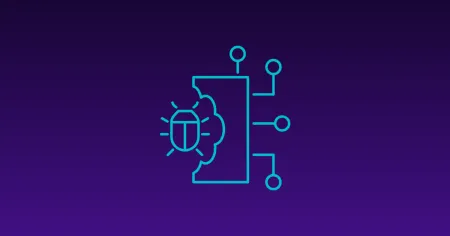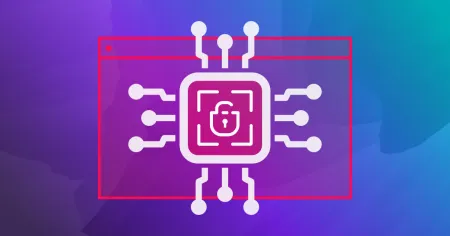Blog
Jan 12, 2024
Top cyberthreats for 2024
Explore OffSec’s predictions for the top cybersecurity threats that will shape the threat landscape in 2024.
10 min read

As we venture deeper into 2024, the digital landscape continues to evolve at a breakneck pace, bringing with it a new era of technological advancements and, unfortunately, sophisticated cybersecurity threats. In an age where our lives are increasingly intertwined with digital platforms, understanding and preparing for these emerging threats is not just prudent; it’s imperative.
This year, we stand at a critical juncture in the realm of cybersecurity. The threats we face are not only more advanced in terms of technology but also more insidious in their approach.
In this blog post, we will delve into the top cybersecurity threats of 2024, exploring how they have evolved from previous years and what new challenges they bring to the table.
1. Ransomware
In 2024, ransomware attacks will become more advanced due to the integration of artificial intelligence and machine learning algorithms. These technologies enable ransomware to identify the most critical data within a system and encrypt it, thereby increasing the pressure on the victim to pay the ransom. Additionally, ransomware-as-a-service (RaaS) has emerged as a significant threat, allowing individuals without extensive technical knowledge to launch ransomware attacks, further increasing the frequency and breadth of these attacks.
The impact of ransomware on organizations can be devastating. It can lead to significant financial losses, both in terms of the ransom paid and the downtime caused by the attack. There’s also the damage to an organization’s reputation, especially if customer data is involved, and the potential legal ramifications of a data breach.
To combat these evolving threats, organizations need to adopt a multi-layered approach to cybersecurity:
- Regular backups: Maintain regular backups of critical data, and ensure these backups are stored offline or in a separate network. This makes it possible to restore data without paying the ransom.
- Employee education: Train employees on cybersecurity best practices, including recognizing phishing emails, which are a common entry point for ransomware.
- Update and patch systems: Regularly update and patch operating systems, software, and firmware. Many ransomware attacks exploit vulnerabilities in outdated systems.
- Advanced threat protection: Implement advanced threat protection solutions that can detect and block ransomware attacks before they can encrypt data.
- Incident response plan: Develop and regularly update an incident response plan. This plan should include steps to isolate infected systems, assess the extent of the damage, and communicate with stakeholders.
- Network segmentation: Segment networks to limit the spread of ransomware. If one segment is compromised, it’s less likely to infect the entire network.
- Regular security audits: Conduct regular security audits and vulnerability assessments to identify and mitigate potential weaknesses in the network.
- Cyber insurance: Consider investing in cyber insurance to mitigate financial losses in the event of a ransomware attack.
2. AI-powered attacks
AI-powered cyber attacks represent a significant and evolving threat in the cybersecurity landscape of 2024. The integration of Artificial Intelligence (AI) in cyber attacks has led to more sophisticated, efficient, and difficult-to-detect threats. Here’s an overview of how AI-powered attacks are shaping the threat landscape in 2024:
- Enhanced phishing attacks: AI algorithms are now being used to craft highly convincing phishing emails. These AI systems analyze vast amounts of data from social media and other sources to create personalized messages that are much more likely to deceive the recipient.
- Automated hacking attempts: AI can automate the process of finding and exploiting vulnerabilities in software and systems. These automated attacks can operate at a scale and speed that is impossible for human hackers, significantly increasing the number of attacks.
- Evasion techniques: AI-powered malware can now change its code to evade detection by traditional antivirus and cybersecurity software. This polymorphic malware can adapt in real-time, making it much harder to identify and neutralize.
- AI-Powered surveillance and espionage: AI can be used to process vast amounts of data quickly, making it an effective tool for surveillance and espionage. This can lead to the theft of sensitive information at a scale previously unimaginable.
The use of AI in cyber attacks complicates the task of cybersecurity professionals. The adaptive nature of these threats means that traditional, signature-based defense mechanisms are often inadequate. The speed and sophistication of AI-powered attacks require equally advanced defensive strategies.
Mitigating AI-powered cyber attacks:
- AI-driven security solutions: Just as AI is used to create more sophisticated attacks, it can also be employed to enhance cybersecurity defenses. AI can analyze patterns, detect anomalies, and respond to threats more quickly than human operators.
- Enhanced detection and response: Organizations need to invest in advanced threat detection and response systems that can adapt and learn from new threats, much like the AI systems used by attackers.
- Collaboration and information sharing: Sharing information about threats and attacks with other organizations and cybersecurity groups can help in developing collective defenses against AI-powered attacks.
- Regular audits and updates: Continuous monitoring, auditing, and updating of cybersecurity practices and infrastructure are essential to stay ahead of AI-powered threats.
3. Supply chain attacks
Supply chain attacks have become a critical concern in the cybersecurity landscape of 2024. These attacks target less secure elements in the supply chain – a network of third-party providers and vendors – to gain access to a larger, more secure network. The interconnectedness of digital systems and the reliance on external suppliers for software and hardware make supply chain attacks particularly insidious and damaging.
As businesses continue to integrate complex and interconnected supply chains, the potential for exploitation has grown. Attackers target weak links – often smaller companies with less robust security – to infiltrate larger organizations.
Attackers are also increasingly exploiting vulnerabilities in third-party software. By inserting malicious code into trusted software, attackers can compromise the systems of all users of that software.
Attackers can leverage the trust established between businesses and their suppliers. Once they compromise a supplier, they can use this trusted status to bypass security measures of the target organization.
The impact of these attacks can be far-reaching. Sensitive data can be exposed, leading to significant financial and reputational damage. Compromised software or hardware can disrupt operations, leading to downtime and loss of business. These attacks can erode trust in the supply chain, causing businesses to question the security of their partners.
Mitigation strategies for 2024:
- Enhanced vendor risk management: Organizations must thoroughly assess and continuously monitor the security posture of their suppliers. This includes conducting regular security audits and requiring vendors to adhere to strict cybersecurity standards.
- Segmentation and access control: Limiting access rights and segmenting networks can reduce the impact of a supply chain attack. If one segment is compromised, it doesn’t necessarily mean the entire network will be affected.
- Real-time monitoring and anomaly detection: Implementing advanced monitoring tools that can detect unusual activities or anomalies in the network can help in early detection of a breach.
- Incident response planning: Having a robust incident response plan that includes scenarios for supply chain compromises is essential. This plan should be regularly updated and tested.
- Collaboration and information sharing: Sharing information about threats with industry peers and participating in collective defense initiatives can help in early detection and prevention of supply chain attacks.
- Secure software development practices: For software suppliers, adopting secure coding practices and regularly updating and patching software is crucial to prevent vulnerabilities.
- Cybersecurity education and awareness: Educating employees about the risks associated with supply chain attacks and training them to recognize potential threats is vital.
4. Cloud misconfigurations
Cloud misconfigurations have emerged as a significant cybersecurity threat in 2024, primarily due to the widespread adoption of cloud services by businesses of all sizes. As organizations continue to migrate data and applications to the cloud, the complexity of cloud environments increases, often leading to configuration errors that can expose sensitive information and systems to potential breaches.
With the adoption of multi-cloud and hybrid cloud strategies, the complexity of managing configurations across different platforms and services has increased, leading to a higher risk of misconfiguration.
The ease and speed of deploying cloud resources can sometimes lead to oversight in security configurations, as teams prioritize functionality and performance over security.
There is often a gap in cloud security expertise, which can result in misconfigurations. This is compounded by insufficient oversight and automated checks on cloud configurations.
Furthermore, as cloud technologies evolve rapidly, keeping up with the latest security best practices and understanding the implications of each configuration setting becomes challenging.
Mitigation strategies for cloud misconfigurations for 2024:
- Automated configuration management tools: Utilize tools that automatically detect and correct misconfigurations in real-time. These tools can enforce security policies and ensure compliance across cloud environments.
- Regular security audits and assessments: Conduct regular security audits of cloud environments to identify and rectify misconfigurations. This should include a review of access controls, network configurations, and data encryption settings.
- Enhanced training and awareness: Invest in cloud security training for IT and development teams to ensure they are aware of the best practices for cloud security and understand the common pitfalls that lead to misconfigurations.
- Implement a DevSecOps culture: Integrate security into the development and deployment processes (DevSecOps) to ensure that security is a consideration at every stage of the cloud deployment lifecycle.
- Strong access control policies: Implement strict access control policies, including the principle of least privilege, to minimize the risk of unauthorized access to cloud resources.
- Continuous monitoring and logging: Establish continuous monitoring and logging of cloud environments to quickly detect and respond to any misconfiguration or suspicious activities.
- Cloud security posture management (CSPM): Deploy CSPM solutions to provide visibility into the security posture of cloud environments and automate the identification and remediation of risks.
5. Cybersecurity skills gap
The cybersecurity skills gap, a persistent issue over the past years, continues to be a significant threat in 2024. This gap refers to the shortage of skilled cybersecurity professionals in the workforce, which leaves organizations vulnerable to cyber attacks. As cyber threats become more sophisticated, the need for skilled professionals to counter these threats grows, but the supply of qualified individuals hasn’t kept pace.
Nature of the cybersecurity skills gap in 2024:
- Rapidly evolving threat landscape: The continuous evolution of cyber threats requires professionals who are not only skilled in current technologies and practices but also capable of adapting to new challenges. This need for advanced and continuously updating skill sets widens the gap.
- Increased demand for cybersecurity professionals: As more businesses undergo digital transformation, the demand for cybersecurity expertise has surged, outstripping the supply of qualified professionals.
- Lack of training and education opportunities: There is often a disconnect between the skills taught in traditional educational programs and the practical, evolving skills needed in the cybersecurity field.
- High burnout rates: The high-pressure nature of cybersecurity work, coupled with the constant need to stay ahead of new threats, leads to burnout, causing professionals to leave the field.
Mitigation strategies for the cybersecurity skills gap for 2024:
- Invest in employee training and development: Organizations should invest in training their existing workforce in cybersecurity practices, including regular upskilling and reskilling programs.
- Promote cybersecurity as a career path: Encouraging interest in cybersecurity careers through outreach in education systems and offering internships or entry-level positions can help to cultivate a new generation of professionals.
- Leverage automation and AI: Implementing AI and automation can alleviate the burden on cybersecurity teams by handling routine tasks and identifying threats, allowing human professionals to focus on more complex issues.
- Foster a culture of continuous learning: Creating a workplace environment that values continuous learning and staying abreast of the latest cybersecurity trends and technologies can help retain talent and keep skills up-to-date.
- Upskill top talent: Upskilling top talent is a crucial strategy in bridging the cybersecurity skills gap, equipping existing workforce with the latest cybersecurity competencies and knowledge to tackle the ever-evolving digital threats.
Conclusion
From the insidious rise of ransomware, the cunning use of AI in cyber attacks, the complexities of supply chain vulnerabilities, to the challenges posed by cloud misconfigurations and the ever-widening cybersecurity skills gap, each threat presents its own unique set of challenges.
The common thread running through these diverse threats is the need for proactive and comprehensive strategies to safeguard digital assets. The evolution of ransomware demands robust backup and employee training programs. AI-powered attacks necessitate the adoption of AI-driven security solutions and continuous monitoring. The intricacies of supply chain attacks call for enhanced vendor risk management and collaboration. Cloud misconfigurations require automated tools and strict access control policies, while the cybersecurity skills gap needs to be addressed through education, training, and a culture of continuous learning.
As daunting as these challenges may seem, they also present opportunities for innovation and collaboration. The cybersecurity community continues to respond with resilience and adaptability, developing new strategies, tools, and practices to stay ahead of threats. Organizations are not only tasked with fortifying their defenses but also with fostering a culture of security awareness and vigilance.
Looking ahead, the key to navigating the cybersecurity landscape of 2024 and beyond lies in our ability to anticipate, adapt, and respond to these evolving threats. It involves a collective effort from individuals, organizations, and governments to build a more secure digital world. By staying informed, prepared, and proactive, we can not only mitigate the risks but also harness the full potential of our increasingly interconnected digital existence.
Stay in the know: Become an OffSec Insider
Get the latest updates about resources, events & promotions from OffSec!
Latest from OffSec

Enterprise Security
How OSCP Holders Can Lead Their Teams to Greater Cybersecurity Resilience
Champion OSCP training in your organization to build a unified, resilient security team.
Apr 11, 2025
6 min read

Research & Tutorials
CVE-2024-57727: Path Traversal Vulnerability in SimpleHelp Web Application
CVE-2024-57727 lets attackers read sensitive files via path traversal in SimpleHelp. Learn more about how attackers exploit this flaw.
Apr 10, 2025
3 min read

Penetration Testing
AI Penetration Testing: How to Secure LLM Systems
Explore how AI penetration testing enhances LLM security, addressing unique vulnerabilities and improving cyber defenses.
Apr 3, 2025
8 min read